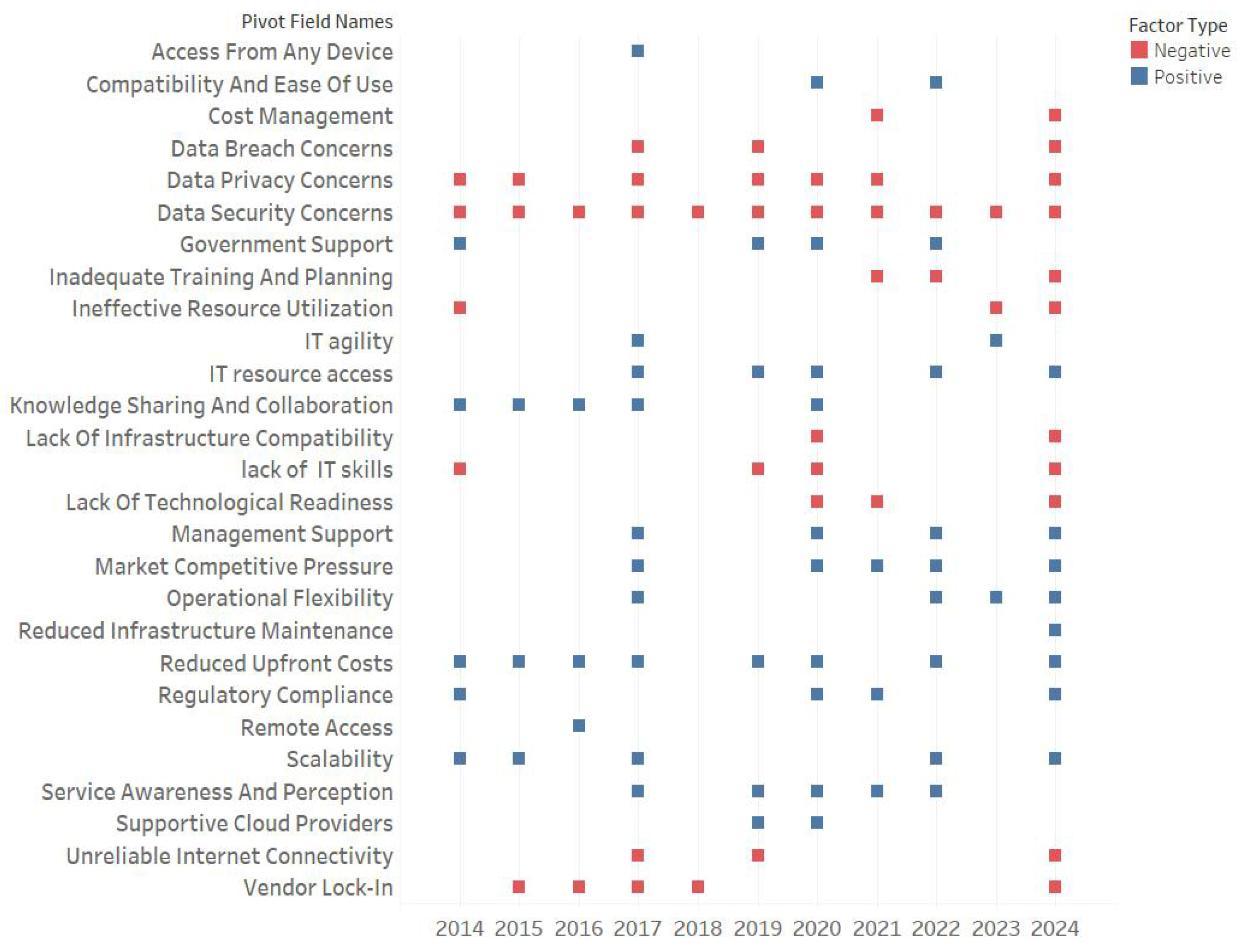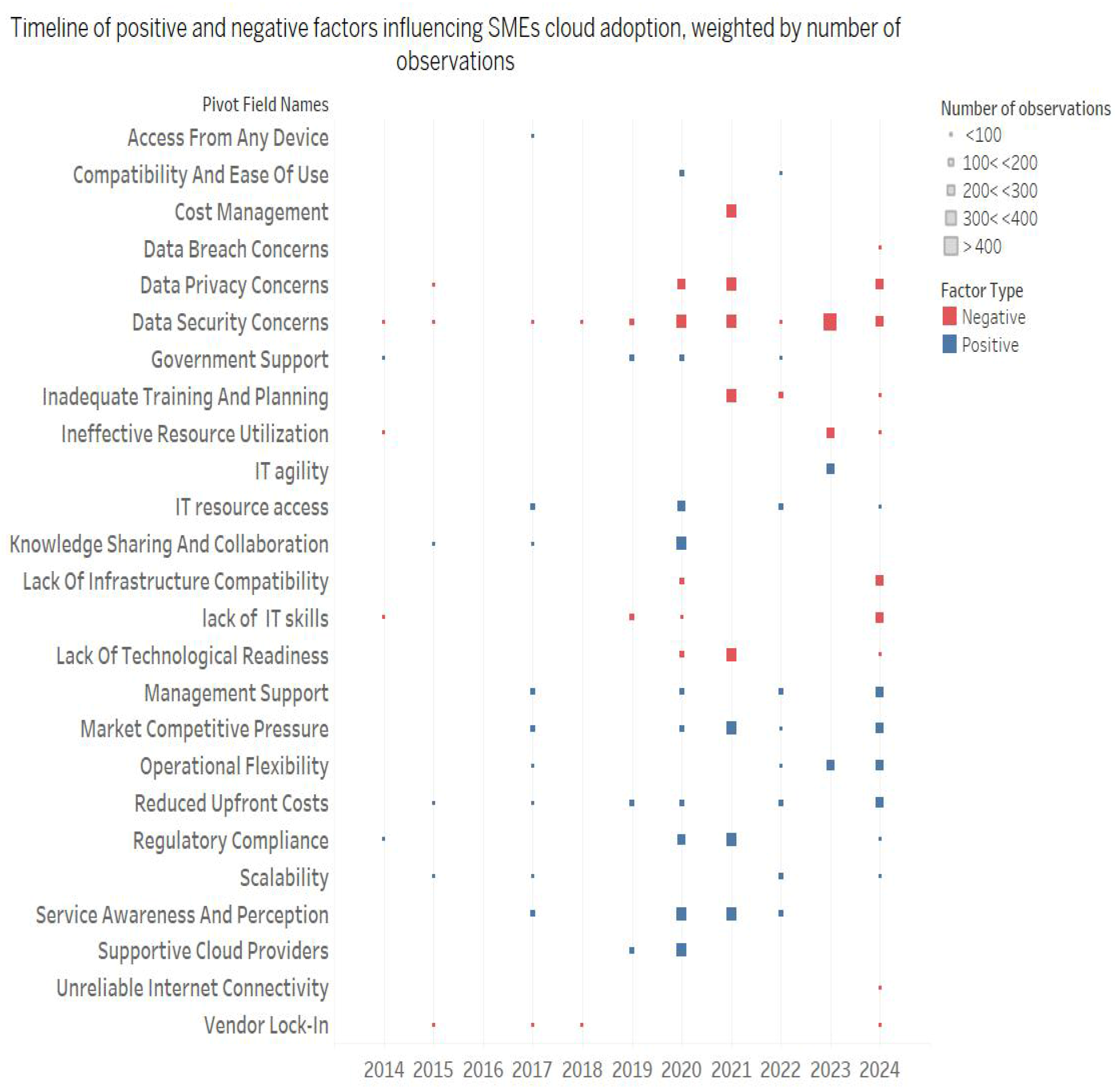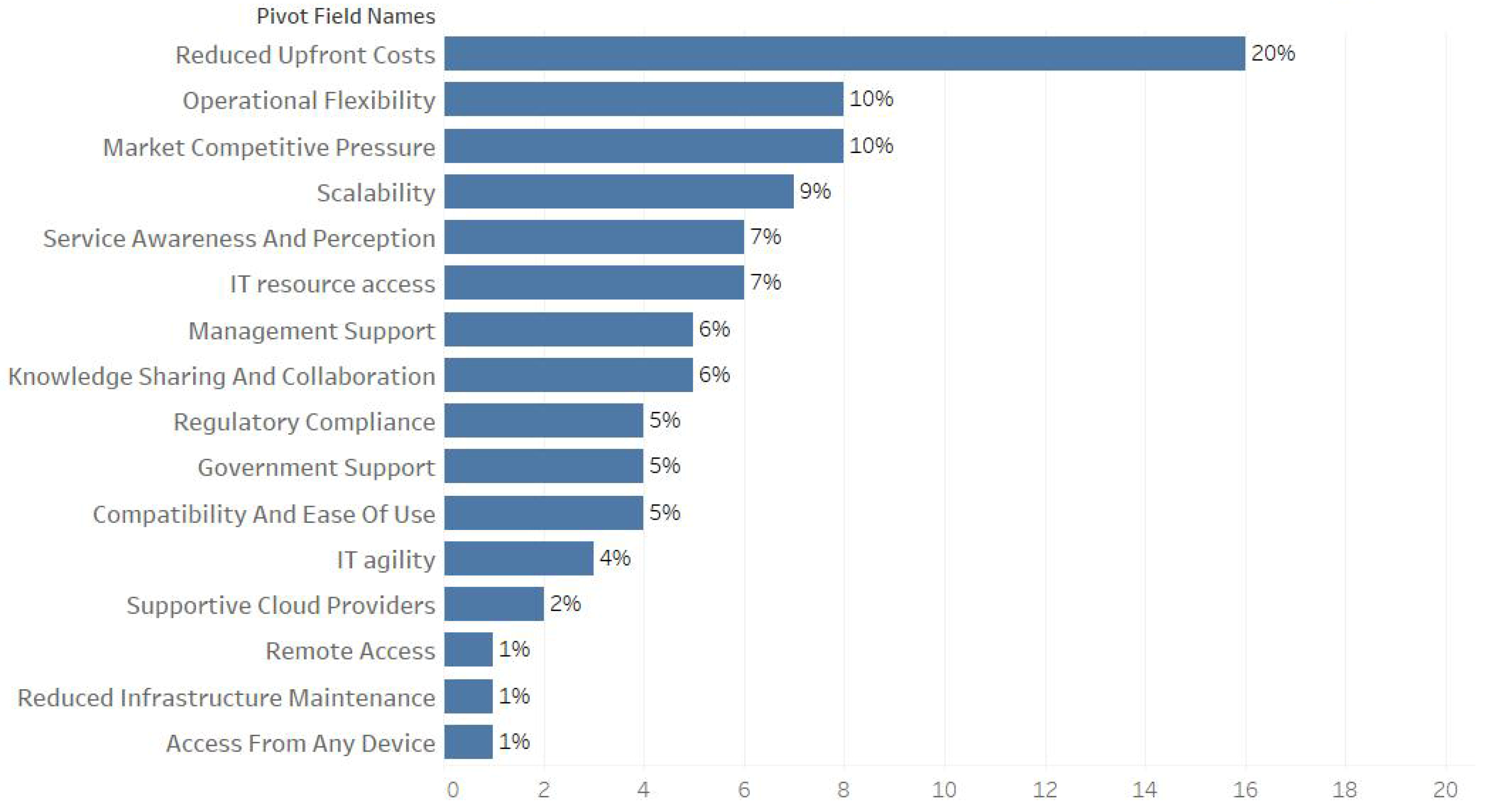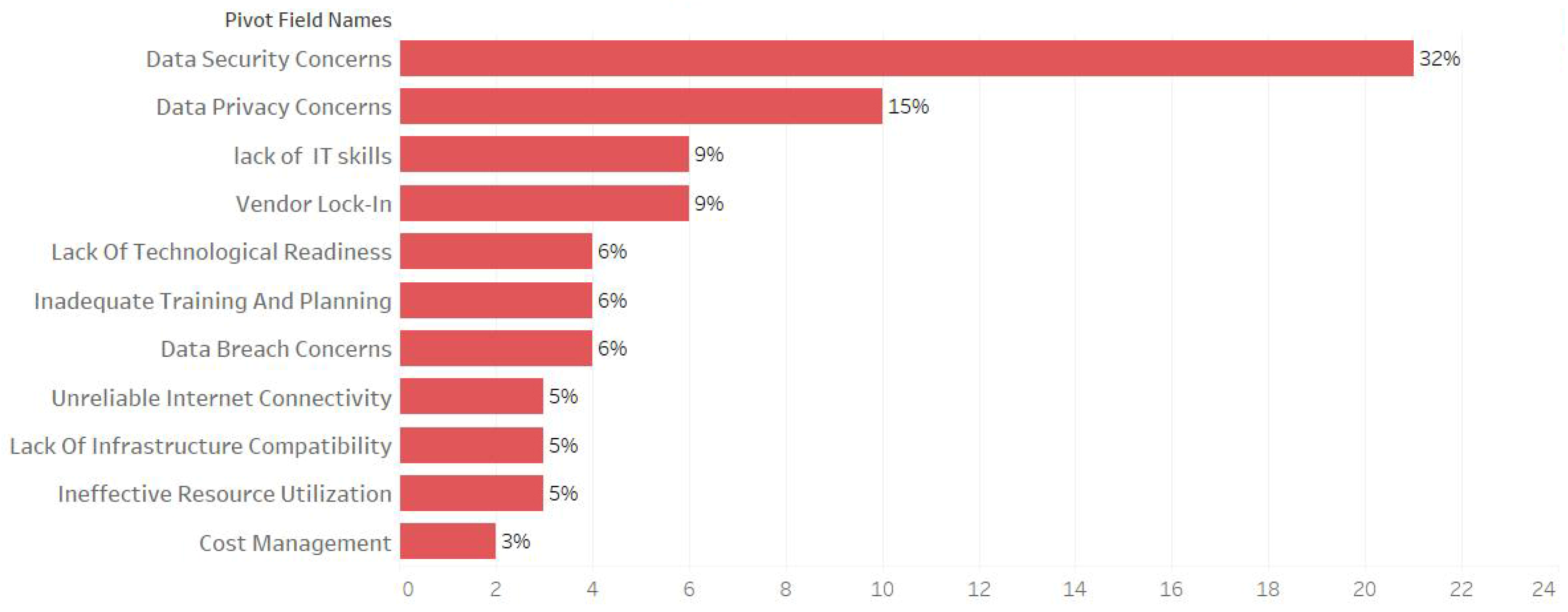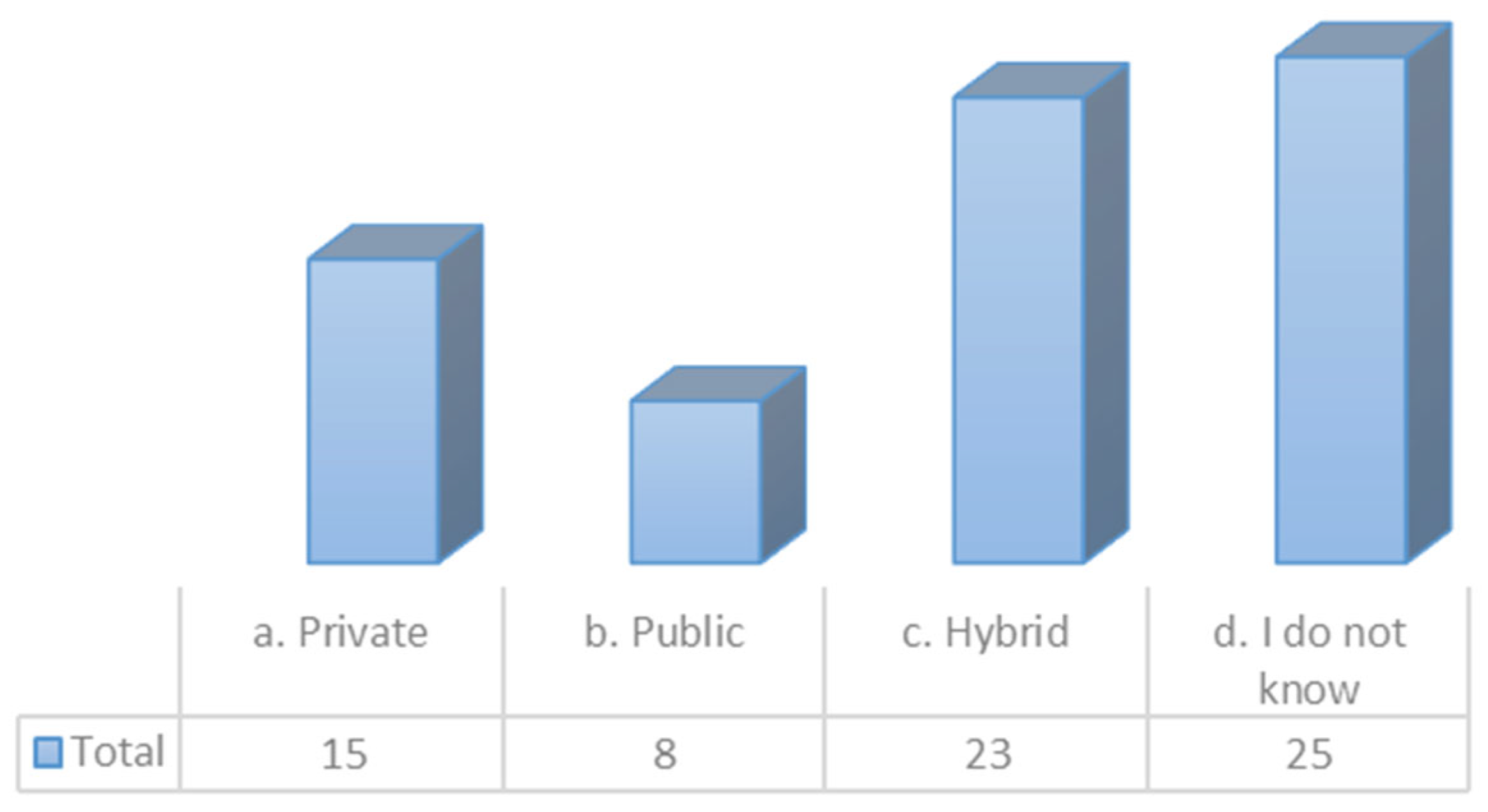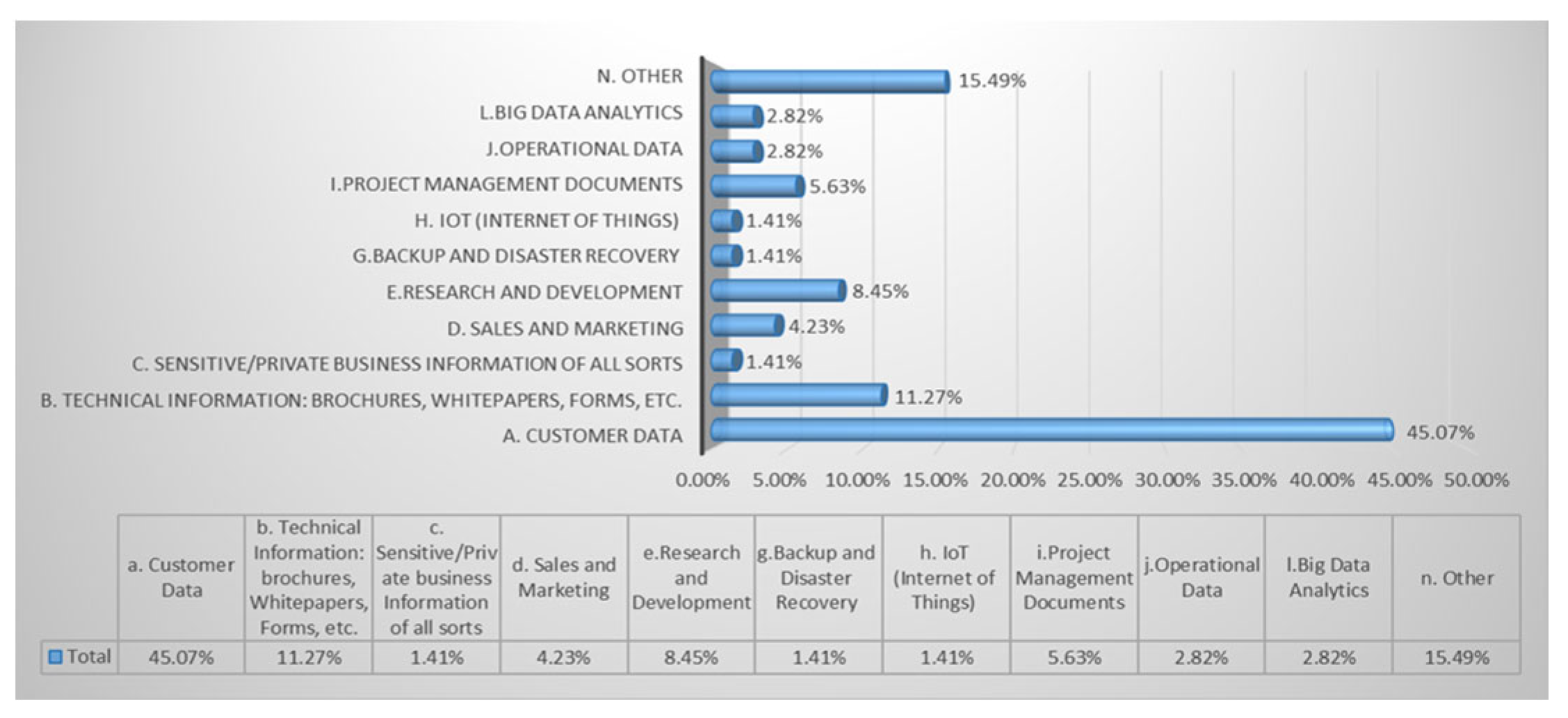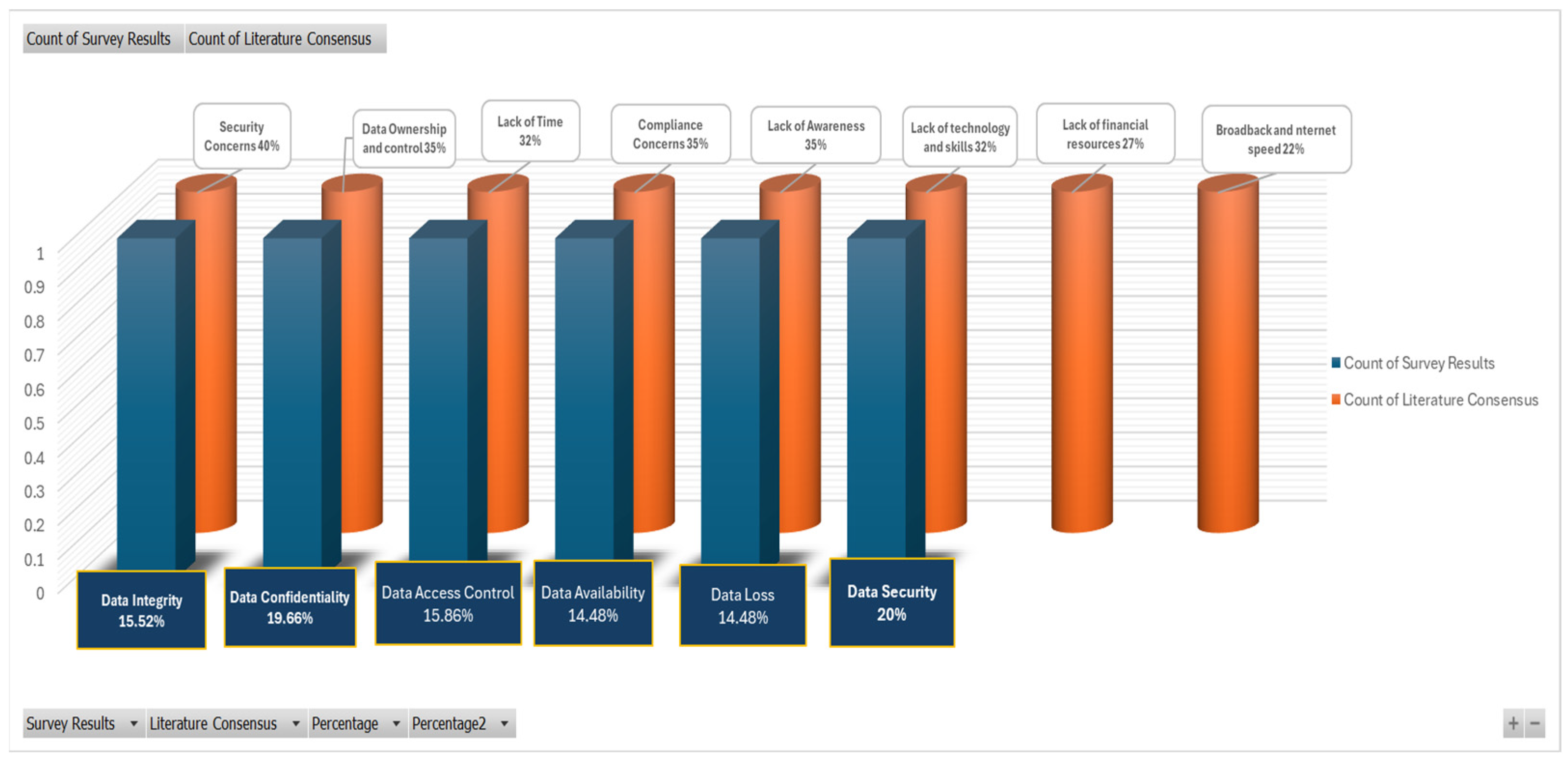1. Introduction
The rapid advancement of technology has revolutionized how businesses operate, communicate, and manage data. Among these technological innovations, cloud computing (CC) has emerged as a transformative approach to data and knowledge management. By offering scalable, cost-effective, and flexible solutions, CC enables businesses to optimize operations and improve their efficiency. Cloud computing services foster collaboration by enabling remote access to data and tools, which is especially important in today’s increasingly globalized work environment. Cloud computing supports business continuity by offering backup solutions and disaster recovery capabilities. The use of cloud computing not only impacts operational efficiency but also drives innovation, enhances customer experiences, and enables data-driven decision-making [
1]. Therefore, cloud computing plays a critical role in helping businesses to adapt to changing market conditions, scale rapidly, and stay competitive in a global digital economy.
Cloud computing refers to a set of software applications delivered as services over the Internet in the form of Software as a Service (SaaS), Platform as a Service (PaaS), or Infrastructure as a Service (IaaS). According to Kaur [
2], “the term cloud computing has been used over the years to mean a number of technologies, including: grid computing, utility computing, Internet-based applications, software-as-a service (SaaS), peer-to-peer computing and remote processing”.
Mell and Grace [
3], in their report for the National Institute of Standards and Technology (NIST), referred to cloud computing as a model enabling convenient, on-demand network access to a shared pool of configurable computing resources. Ioniţă and Ioniţă [
4] referred to cloud computing as an infrastructure that provides resources and/or services over the Internet and consists of storage clouds, data clouds, and computer clouds. A service cloud is responsible for service storage, a data cloud must provide data management services, and the computer cloud provides software and computational services. These parts work together to create a platform for cloud-based applications.
The advancements in mobile devices have shifted the use of cloud computing from desktops to mobile devices such as smartphones. This increase in mobile devices can be viewed as a driving force for virtual digital services [
5]. Cloud technologies allow for greater collaboration among employees, as users can contribute from remote locations, saving time and money among organizations. This emerging need for remote access to data has contributed to an increased need for enterprises to be more flexible in allowing its employees and customers to access data and, at the same time, safeguard information infrastructure and cybersecurity [
6,
7].
Despite the growing recognition of the advantages of cloud computing, there are still questions and issues regarding scalability, cost-effectiveness, remote accessibility, privacy, security, long-term preservation, and sustainability. There is a need for a better understanding of the barriers and challenges faced by enterprises in integrating cloud computing into their digital transformation strategies. This study aims at addressing the following questions: (1) How does the adoption of cloud computing influence the digital transformation in the enterprise? (2) What are the measurable outcomes of cloud computing adoption on the enterprise’s performance, innovation, and competitiveness? (3) What are the barriers and challenges faced by the enterprise in integrating cloud computing into its digital transformation strategy? The findings from this study aim to fill the gap in the literature regarding the influence of cloud computing on the digital transformation of the enterprise and, at the same time, provide insights into the adoption and use of cloud computing.
2. Literature Review
There has been a proliferation of studies concerning the adoption and use of cloud computing in the enterprise. However, there is still a gap in the literature regarding the impact of cloud computing on the digital transformation of the enterprise, including the long-term preservation and sustainability of enterprise data. There are always challenges when it comes to the adoption of cloud computing services. Privacy and security concerns always emerge in regard to any aspect related to customer data and its use over the Internet [
8] Talib et al. [
9] address some of the challenges, highlighting the need to create mechanisms in information security that better respond to the challenges in information discovery processes. Today, building IT infrastructure and creating a knowledge management system is rather expensive. Cloud computing reduces these costs by eliminating the need to acquire inhouse hardware and software.
However, several studies have highlighted the complexity associated with service-based costing for cloud computing [
10,
11,
12]. They point out that, despite technological advancements, the lack of comprehensive and practical economic models hinders the widespread adoption of cloud computing. Data security and privacy is still an issue that hinders the adoption and implementation of cloud computing. Raja [
13] explored the challenges and solutions related to data security and privacy in cloud computing environments. Their results emphasized that, while cloud computing offers scalability and flexibility, ensuring data security requires robust encryption, stringent access controls, and reliable CSPs. Their study concluded that ongoing research and innovative security solutions are essential to mitigate cloud-related risks and enhance user trust.
A bibliometric study by Ruslaini [
14] was carried out using data from 246 articles in the Scopus database, published between 2010 and 2024. Data collection involved bibliometric analysis using the VOSviewer 1.6.20 and Bibliometrix 5.0 tools; the data described the evolution of cloud adoption in SMEs, highlighting cost efficiency, operational flexibility, and data security as the primary issues affecting the digital transformation of SMEs. The results indicated that, while cloud adoption enhances SMEs’ competitiveness and innovation, challenges such as data privacy, technical expertise, and system integration persist. Nagahawatta et al. [
15] explored the role of security and privacy factors in cloud computing adoption by SMEs, aiming to identify key concerns that influence adoption decisions. Their study reviewed 21 research papers focusing on sociotechnical security challenges. It categorized security and privacy factors into eight key dimensions, including data security, privacy, trust in cloud service providers (CSPs), legal compliance, and cloud security standards. The findings indicate that data security concerns (25.8%) and privacy risks (17.7%) are the most cited barriers to adoption, followed by technology readiness and skilled personnel shortages. The study highlights that SMEs, particularly in developing regions, perceive security issues as complex and lack transparency regarding cloud provider security measures. The authors conclude that enhancing regulatory compliance, increasing awareness, and improving trust in CSPs are essential in boosting cloud adoption in SMEs, while future research should explore human factors and institutional pressures influencing cloud security perceptions.
Cost and pricing schemes have been cited in the literature as one of the factors that significantly impact the adoption of cloud computing by SMEs. Zhou et al. [
11] investigated the impact of pricing schemes on cloud computing and distributed systems, focusing on their implications for economic efficiency, system performance, and user cost management. The study analyzed cost variations in pricing schemes such as pay-as-you-go, dynamic, and auction-based pricing models and concluded that more sophisticated, equitable, and adaptive pricing models are necessary to optimize cloud resource allocation, ensure fairness, and enhance cost efficiency while maintaining system effectiveness. Wang et al. [
16] examined the integration of cloud computing in human resource management (HRM) systems for SMEs, highlighting its potential to enhance efficiency, reduce costs, and improve decision-making. Their research categorized applications into HRM alliances for resource sharing, HRM consulting services for remote expertise, and shared HR services for the optimization of recruitment, training, performance management, and compensation. The study concluded that, while cloud computing significantly benefits SMEs’ HRM processes, challenges like data security, vendor management, and system integration require further attention to ensure optimal implementation.
Technology and infrastructure are cited in the literature as an issue for SMEs, especially in developing countries [
17,
18,
19,
20]. Mohammad and Abbas [
21] examined the challenges of cloud computing resource allocation (RACC) in small and medium enterprises (SMEs) using the Technology–Organization–Environment (TOE) framework. Through semi-structured interviews with 12 experts from SMEs in the United States, the United Kingdom, India, and Pakistan, they identified 11 key barriers across three categories: technological (a lack of knowledge, expertise, security/privacy concerns, network performance, and optimization), organizational (cost efficiency, inadequate training, and resource monitoring difficulties), and environmental (economic constraints, market competition, and scalability issues). The study emphasizes that, despite cloud computing’s flexibility, scalability, and cost efficiency, SMEs struggle with effective resource utilization. Sayginer and Ercan [
22] investigated the factors influencing cloud computing adoption in Turkish SMEs using an integrated Diffusion of Innovation (DOI) theory and Technology–Organization–Environment (TOE) framework. The study aimed to identify drivers, barriers, and decision-making factors that affect cloud adoption in SMEs. The results indicate that Turkish SMEs lag in cloud adoption, primarily using Infrastructure as a Service (IaaS) (53.5%) rather than Software as a Service (SaaS) (18.5%), due to security concerns, a lack of IT expertise, and regulatory uncertainties. This finding is similar to other studies highlighting security, regulatory frameworks, and the need for increasing awareness among SMEs to accelerate adoption [
23,
24,
25]. The same sentiment was echoed in Carcary et al.’s [
26] study of 95 Irish SMEs, highlighting both the adoption trends and barriers faced by small businesses. Their study suggests that Irish SMEs often lack the formal planning and technical expertise required for cloud adoption, leading to suboptimal implementation. The authors emphasize the need for government support, industry awareness campaigns, and SME-specific adoption frameworks to bridge these gaps.
Knowledge management and ERP systems can play a significant role in highlighting the benefits of cloud computing. At the same time, cloud computing seamlessly enhances knowledge sharing, access, discovery, and retention [
27,
28,
29,
30]. Bhatia et al. [
2] indicated in their study that cloud-based ERP systems and Internet-based systems are particularly beneficial for SMEs due to reduced upfront costs, scalability, and flexibility, although security and vendor lock-in remain concerns. Their study concluded that a QoS-based selection framework can help SMEs to choose the most suitable cloud ERP solutions, enhancing their operational efficiency and reducing the costs. Aksoy and Algawiaz [
31] argued that effective knowledge management requires dynamic alignment with evolving technological paradigms like cloud computing. The results of their study revealed that cloud computing significantly enhances knowledge acquisition, sharing, and utilization by reducing infrastructure costs and simplifying collaboration, provided that organizations can implement robust security protocols and establish clear guidelines for data governance to mitigate the associated risks.
Several studies have discussed the human elements pertaining to the issues impacting the adoption and implementation of cloud computing [
32,
33]. Neicu et al. [
34] conduct an empirical study to analyze SME employees’ perceptions of cloud computing usage, focusing on factors influencing perceived quality and satisfaction. The findings of the study indicated that the perceived benefits, communication quality, and service image positively impacted perceived quality, while the perceived risks did not significantly influence adoption. Gibreel et al. [
33] examined the socioeconomic, cultural, and technical barriers to cloud computing adoption among SMEs in Kuwait. The results show that factors such as trust in supervisors, perceived cost savings, and procedural justice positively influence cloud adoption. In contrast, cultural tendencies toward uncertainty avoidance, cybersecurity apprehension, and the perceived complexity of IT systems act as significant deterrents. Other studies have shown that, while cloud computing is viewed positively by users and IT professionals, insufficient training, a lack of executive sponsorship, and limited awareness of advanced applications are impeding progress [
35,
36,
37].
External factors such as the COVID-19 pandemic have had a profound impact on the adoption of cloud computing. As enterprises faced unprecedented disruptions to their operations, digital communications and cloud-based technologies emerged as enablers of business continuity [
38]. Enterprises allowed remote work and sought to migrate their legacy systems to cloud platforms to ensure operability and reduce the reliance on physical infrastructure. With increased excess liquidity, enterprises also sought to acquire a range of technological products needed to support e-learning platforms, telehealth services, e-commerce systems, and digital supply chains [
39,
40,
41]. This digital transformation prompted investments in automation, AI, and data analytics tools integrated into cloud environments [
42]. However, in the post-pandemic era, studies will be needed to examine the effects of liquidity and inflation on the sustainability of cloud computing solutions and their effects on the digital transformation of the enterprise.
5. Results and Analysis
The systematic literature review in this study was aimed at assessing the work conducted so far in this area and developing a better understanding of the impacts of cloud computing on the digital transformation of the enterprise. This rigorous analysis process ensured the inclusion of high-quality, relevant literature related to the use of cloud computing in the enterprise. The search on EBSCO, which included 121 databases through UNT Libraries using terms such as “cloud computing adoption” and “factors impacting the use of cloud computing”, resulted in 1959 hits. The same search using the same terms on Google Scholar resulted in 124,000 hits. To reduce the number of hits, more specific terms, such as “privacy”, “security”, “awareness”, and “preservation”, were applied, reducing the results to a manageable size. After applying the inclusion and exclusion criteria, the final list was reduced to 30 studies published during the period from 2014 to 2024.
The selected studies were analyzed using coding and thematic analysis. The content analysis of the selected publications identified both positive and negative factors influencing cloud computing adoption, use, and acceptance.
Figure 1 presents a timeline of the positive (blue) and negative (red) factors influencing SMEs’ adoption of cloud computing over the 2014–2024 period. According to
Figure 1, positive factors such as remote access, scalability, reduced upfront costs, operational flexibility, and IT agility have consistently encouraged adoption. In contrast, concerns over data breaches, privacy, and security have remained the most persistent barriers, underscoring ongoing trust issues. In recent years, new enablers such as supportive cloud providers and market pressure have emerged, while challenges like vendor lock-in and limited IT skills continue to pose obstacles. Overall, the trend points to a growing presence of positive drivers, even though data-related concerns remain a critical challenge for most enterprises.
Figure 2 shows a timeline of the positive and negative factors influencing cloud adoption among SMEs from 2014 to 2024, weighted by the number of observations.
Figure 2 shows that positive factors such as reduced upfront costs, scalability, operational flexibility, and IT agility have become more prominent in recent years, often supported by larger-scale studies. On the other hand, negative factors like data security, data privacy, and vendor lock-in are common barriers reported by other studies.
Figure 3 shows the percentage of studies highlighting positive factors influencing the adoption of cloud computing. The most common benefit in using cloud computing is reduced upfront costs. The results show that 20% of the studies reported that saving money is the greatest motivator for cloud computing adoption. Operational flexibility and market pressure come next at 10%, meaning that businesses wish to be more flexible and keep up with the competition. Other benefits like scalability (9%), better service awareness (7%), and easier access to IT resources (7%) are also important. Some factors, like remote access and access from any device, are mentioned less often. Overall, saving money and being more adaptable are the top reasons that SMEs turn to cloud computing.
Figure 4 shows the percentage of studies highlighting the negative factors discouraging the adoption of cloud computing by SMEs. Data security is the most mentioned issue, appearing in 32% of studies, followed by data privacy at 15%, showing that trust in cloud safety is a major barrier. Other common concerns include a lack of IT skills and vendor lock-in, both at 9%, suggesting that limited expertise and dependencies on specific providers are also problematic. Factors like technological readiness, training and planning, and data breach concerns appear in 6% of the studies. Less frequently mentioned issues include Internet connectivity, infrastructure compatibility, resource utilization, and cost management. Overall, security, privacy, and skill gaps are the top reasons for the lack of enterprise adoption.
The online survey obtained a total of 71 complete and valid responses, with all participants answering every question. The response rate for fully completed responses was deemed satisfactory, as the survey provided sufficient data to draw meaningful results and conclusions. The survey was distributed via Microsoft 365 Forms, a platform that some participants may not have been familiar with or comfortable using due to system login requirements, particularly if they used different tools (e.g., Google Workspace). Organizational policies or firewalls may also have limited access to external links, restricting the survey’s reach. One means to attract more responses is to use tangible incentives. The researchers decided not to use incentives so as to eliminate any potential bias. To ensure reliability, the researchers also not only considered the number of responses but also the diversity of the population and the distribution of the responses across different subgroups.
The survey’s internal reliability was assessed across constructs such as cloud strategic readiness, privacy and security, and long-term preservation. The overall Cronbach’s alpha for the Likert-style items ranged from 0.67 to 0.83, indicating moderate to strong internal consistency. The survey results revealed a notable degree of participation from larger companies, with 50% of the respondents coming from organizations with over 250 employees. This indicates strong representation from large enterprises within the dataset. The distribution of responses by company size varied, with 28.2% of the respondents from small companies, 18.3% from medium-sized enterprises, and 38 (53.5%) for large-sized enterprises. Information technology/high-tech was the most represented sector, with 32.4%, followed by education/training with 36.6%.
A significant number of participants, namely 81.7%, indicated that their companies had already adopted cloud solutions. This suggests that cloud adoption was widespread across the surveyed organizations.
Figure 5 shows a breakdown of participants’ beliefs regarding how their organizations view the benefits of using a cloud-based system. Regarding the type of cloud deployment, 32.4% of the respondents reported using hybrid cloud services, while 21.1% used private clouds and 11.3% used public clouds. Notably, 35.2% of the respondents were unsure of the type of cloud service that their companies used, highlighting a potential gap in internal communication or awareness.
The results reveal that 32.4% of the participants’ companies used hybrid cloud services, suggesting a trend toward adopting a flexible mix of private and public cloud services to balance scalability and security. Private cloud services were used by 21.1%, indicating moderate interest in maintaining secure, dedicated cloud environments. In contrast, only 11.3% of the participants reported using public cloud services, reflecting a smaller adoption rate, possibly due to concerns about security and privacy issues. The results show that 35.2% of the participants were unsure or unaware of the type of cloud services used in their companies, signaling a possible lack of clarity and communication within these organizations (32.4%). This suggests that, while hybrid and private clouds are prevalent, many companies still face challenges in effectively communicating and understanding their cloud strategies.
The survey findings reveal that most companies primarily utilize cloud services for the storage and management of customer data, with 45.07% of participants identifying this as the main use case. This highlights the central role of cloud computing in managing sensitive and critical customer-related information. Following customer data, a significant portion of companies, 15.49%, reported using the cloud to store various other types of materials, categorized as “other data types”. Additionally, 11.27% of the respondents indicated that their companies used the cloud to store and manage technical information, such as software configurations, system logs, and other operational data (
Figure 6).
A substantial 32.4% of the respondents reported that over 60% of their company’s data was stored in the cloud, while 25.4% indicated that most of their data resided in cloud environments. However, 26.8% of the respondents did not know the proportion of data stored in the cloud, suggesting that data storage strategies may not be well communicated across organizations. The results indicate a substantial dependence on cloud services for data management and storage, demonstrating that many organizations have integrated cloud computing as a fundamental part of their data infrastructure.
In terms of cloud expertise, 40.8% of the respondents identified themselves as having 1 to 5 years of cloud experience, while 33.8% described themselves as beginners. Only 14.1% considered themselves experts, and 11.3% reported no experience. Regarding access, 238.0% reported that cloud services were available to all employees, while 33.8% stated that access was restricted, and 28.2% of the respondents were unsure. In terms of cloud services’ availability to employees across organizations, 38.3% of the participants stated that cloud solutions were widely available for employees across organizations, 33.08% stated that cloud computing was not widely available for employees, and 28.17% did not know.
Regarding training, 46.5% of the respondents reported that their companies did not offer cloud-related training, while 36.6% confirmed that training was available, and 16.9% were unsure. For staffing, 69.0% of the respondents indicated that their organizations had qualified staff to support cloud initiatives. Meanwhile, approximately 70% of the participants stated that trained experts in cloud solutions were available to support the organization, while 22.54% did not know if support was available.
Security and privacy remain primary concerns for cloud adoption, with 64.8% of the respondents acknowledging that their companies had concerns about data privacy and security. Their concerns included data confidentiality at 80.3%, data security at 81.7%, data access and control at 64.8%, and data availability at 59.2%.
Figure 7 shows the types of issues that companies are concerned with in regard to security and privacy.
As for the digital transformation and long-term preservation, 52.1% of the respondents reported having such strategies in place, while 38.0% were unsure and 9.9% stated that no strategy existed. Additionally, 25.4% of the respondents confirmed that their data was backed up on the cloud, while 32.4% were unsure and 12.7% indicated no backup practices. Regarding the existence of backup plans, 54.93% claimed that their organizations had a backup plan for data management, while 32.39% were not sure and 12.68% stated that there was no backup plan in place.
Regarding the perceived cost benefits of cloud computing, opinions were split in terms of whether the cost benefits of the cloud outweigh security, privacy, and preservation concerns, where 40.8% believed that the benefits outweighed the risks, while 25.4% disagreed. The survey results revealed that increased collaboration was the most identified benefit of cloud computing, with 50.7% of the respondents emphasizing the importance of enhancing teamwork and communication across teams or locations. IT efficiency followed as the second most cited advantage, with 19.7% recognizing the streamlining of IT operations and improved system management. Scalability, or the ability to increase or decrease one’s capacity, was noted by 18.3%, reflecting the flexibility that cloud solutions provide in adapting to fluctuating business needs.
6. Discussion and Conclusions
The survey findings highlight several significant challenges that organizations face in adopting cloud computing, such as integration issues, data sovereignty and privacy concerns, financial constraints, and security. Integration challenges often arise when aligning cloud technologies with existing legacy systems, leading to inefficiencies and increased costs [
52]. Concerns about data sovereignty and privacy have been widely discussed in the literature, with organizations wary of regulatory implications and the potential for unauthorized access to sensitive data [
53]. Financial constraints also remain a critical factor, as businesses, especially small and medium-sized enterprises, struggle with the initial costs of cloud implementation and ongoing operational expenses [
54].
Security concerns continue to be paramount, as organizations worry about data breaches, loss of control over their information, and vulnerabilities within cloud service providers’ infrastructures [
55]. Moreover, 10.62% of the survey respondents noted that regulatory issues were another significant hurdle, aligning with the findings of previous studies that highlight the complexities involved in complying with varying national and international laws [
56]. These challenges underscore the need for comprehensive strategies to address both the technical and regulatory aspects of cloud adoption. In terms of cloud service providers, 36.62% indicated using Microsoft, followed by 25.35% using Amazon and 21.13% using Google. In terms of the level of satisfaction with these services, 60.56% were satisfied, while 28.17% of the participants did not feel confident in evaluating the performance of these services.
Figure 8 provides insights from the literature in comparison with the survey’s key findings. The results indicate that cloud adoption is widespread across industries and organizations of all sizes, highlighting its universal appeal. Both small and large organizations benefit from cloud technologies, leveraging them to enhance collaboration, increase IT efficiency, and achieve operational cost savings. Scalability also stands out as a key advantage, enabling organizations to adapt their resources based on the demand. Rafiq, Bashar, and Shaikh [
57] argue that cloud computing transforms knowledge management practices by integrating cloud technologies in managing and disseminating organizational knowledge. This integration supports innovation in knowledge management processes, particularly for global businesses, by enabling efficient knowledge storage, sharing, and accessibility while addressing emerging trends and challenges. Cloud technologies play a critical role in transforming business operations, supporting data storage, customer information management, research and development, and disaster recovery systems.
Despite these advantages, a significant number of respondents highlighted the need for training and capacity building to maximize its potential. A lack of qualified technical staff further underscores the skill gap in managing cloud technologies effectively. Moreover, security and privacy concerns remain critical barriers to adoption, with data confidentiality, data loss, and breaches cited as major challenges. Organizations also express concern regarding regulatory compliance, data sovereignty, and integration issues. Financial constraints and a limited awareness of cloud benefits further hinder broader adoption. Furthermore, satisfaction with cloud providers is mixed, with most respondents reporting neutral or somewhat satisfied experiences, suggesting areas for improvement in customer service and technical support.
Cloud services have become an integral part of modern business operations and personal data management, offering a flexible, cost-effective way to store, access, and process data remotely. With increasing amounts of data being generated daily, businesses and individuals alike are turning to cloud platforms for storage solutions, collaboration, and more. The results of the systematic literature review and the survey provide valuable insights into the status of cloud computing and the digital transformation of the enterprise. The results reveal that there is growing recognition of the benefits of cloud computing in terms of cost reduction, scalability, and efficiency, as well as the need for long-term preservation and curation. Kumalo et al. [
58] emphasize the importance of data protection regulations—particularly the General Data Protection Regulation (GDPR)—given the global nature of data exposure in cloud environments, where data is often stored off-premises and managed outside national borders.
The results of this study indicate that factors concerning data availability, security, integrity, confidentiality, data breaches, and hijacking are still affecting the digital transformation. The study underscores the importance of addressing these issues in addition to long-term preservation and digital curation. The findings and practical implications of this study could guide decision-makers, IT professionals, and service providers in developing strategies that address the specific issues impeding progress toward full integration. A better understanding of these factors would allow businesses of all sizes and segments to leverage cloud computing to improve their operations and enhance their competitive edge in an increasing globalized digital economy.
